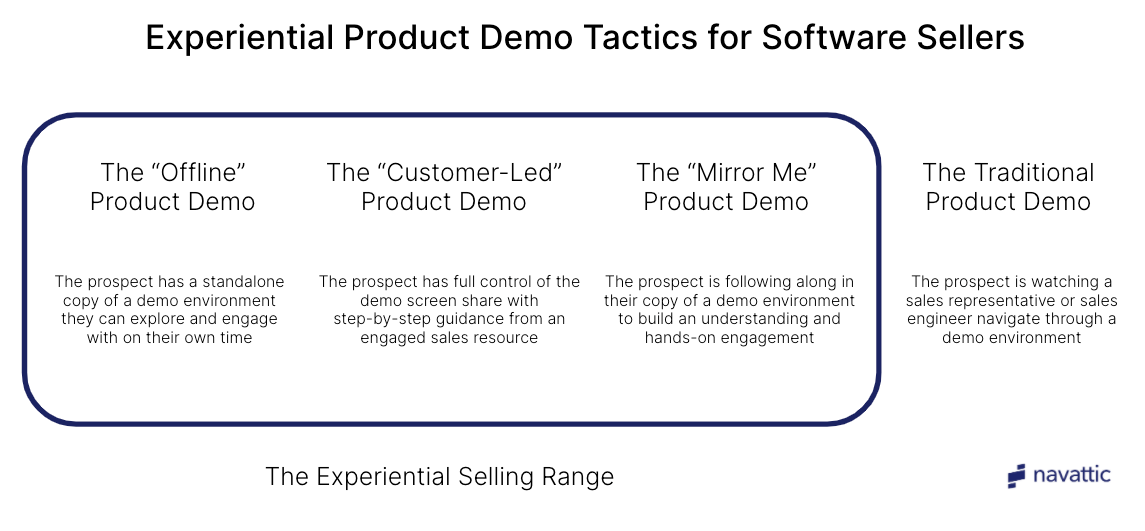The Art of Experiential Selling

CEO, Co-Founder
The product demonstration (product demo) is an essential part of the B2B sales process. 58% of enterprise software buyers cited the “product demonstration” as the top call to action they would respond to in a marketing campaign. The product demo is the first opportunity the buyer has to visualize the value of a product with concrete examples and use cases. In a sales world where software buyers are inundated with abstract claims about product business value, the product demo is a golden opportunity for software sellers to stand out with real, tangible results.
So what is experiential selling?
A strong demo enables prospective buyers to visualize how a solution fits into their business and meets their unique challenges. Typically, a product demo consists of a sales rep or technical sales engineer walking a prospect through a product tour either face-to-face or on a virtual screen share. However, the product demo is traditionally a one-directional experience. This “show and tell” method leaves a prospect off to the side while a sales representative presents a product overview.
While the prospect can stop and ask questions, they are watching rather than experiencing the product demonstration. This difference is key. Watching a sales engineer click through a demo environment over a screen share is not the same as exploring a product first-hand.
Experiential selling puts your prospect in the driver seat to explore various components of an application at their own speed.
Software buyers are curious. The reason they requested a demo to begin with was to understand how a product works for their unique use case.
Prospect Engagement, Like Never Before
In a largely virtual selling world where video calls dominate our calendars and limited time, attention is a rare commodity. Let’s face it, when a prospect is on a video conference with a seller starting the product demo and an important email comes through their inbox, most prospects will open that email taking their attention away from the product overview.
Participation is a two-way street.
Actively engaging a prospective buyer in a virtual environment is a challenge that software sales teams face daily. Pausing for questions is one strategy to ensure that a prospect is actively involved in a conversation. However, that pressing email is still top of mind.
Experiential selling is a forcing function to put a prospect in a position where they are actively engaged with an interactive and exciting product experience.
How does this work?
Experiential selling is not a one-size fits all solution to the product demo. Depending on the type of product and standard buying cycle, there are different ways to engage your prospect through interactive experiences.
What Experiential Selling Isn’t
Experiential selling is not a proof-of-concept.
A proof of concept (POC) is a time intensive commitment a sales team makes in the buying cycle. A vendor organization must engage a sales resource and technical product expert to engage with a prospect to capture requirements and train a user on a tool before hanging over the keys to the POC. This time requirement is often not practical for SMB or mid-market deals.
Experiential selling is not a trial.
A limited sandbox trial or lite version of an application is a method to engage a prospect with a tool prior to advancing with the sale. However, traditional product trials drop prospects into an empty environment, often without instructions on how to navigate throughout the platform.
Experiential selling is a strategy that supports the presales process. Sales teams need to be cautious that an experiential selling session does not turn into a product training. The intent of experiential sales is to close the deal. The onboarding and training will come later.

Who Can Utilize Experiential Selling?
Experiential selling supports the following persona groups:
- Account Executives - Power organizational champions with engaging material to share with internal stakeholders for buy-in
- Product marketing - Build new leads with engaging early customer content using “offline” product demos
- Technical Presales & Sales Engineers - Put your prospect in the driver seat throughout the product demo process to gain natural buy-in and product understanding
Experiential selling is a tactic employed by sales teams to better engage prospective customers with hands-on product experience earlier in the buying cycle. It scratches the itch to engage with a product without needing to roll out a full POC or product trial. Experiential sales tactics help keep prospects active, engaged, and in the driver’s seat throughout the buying cycle.